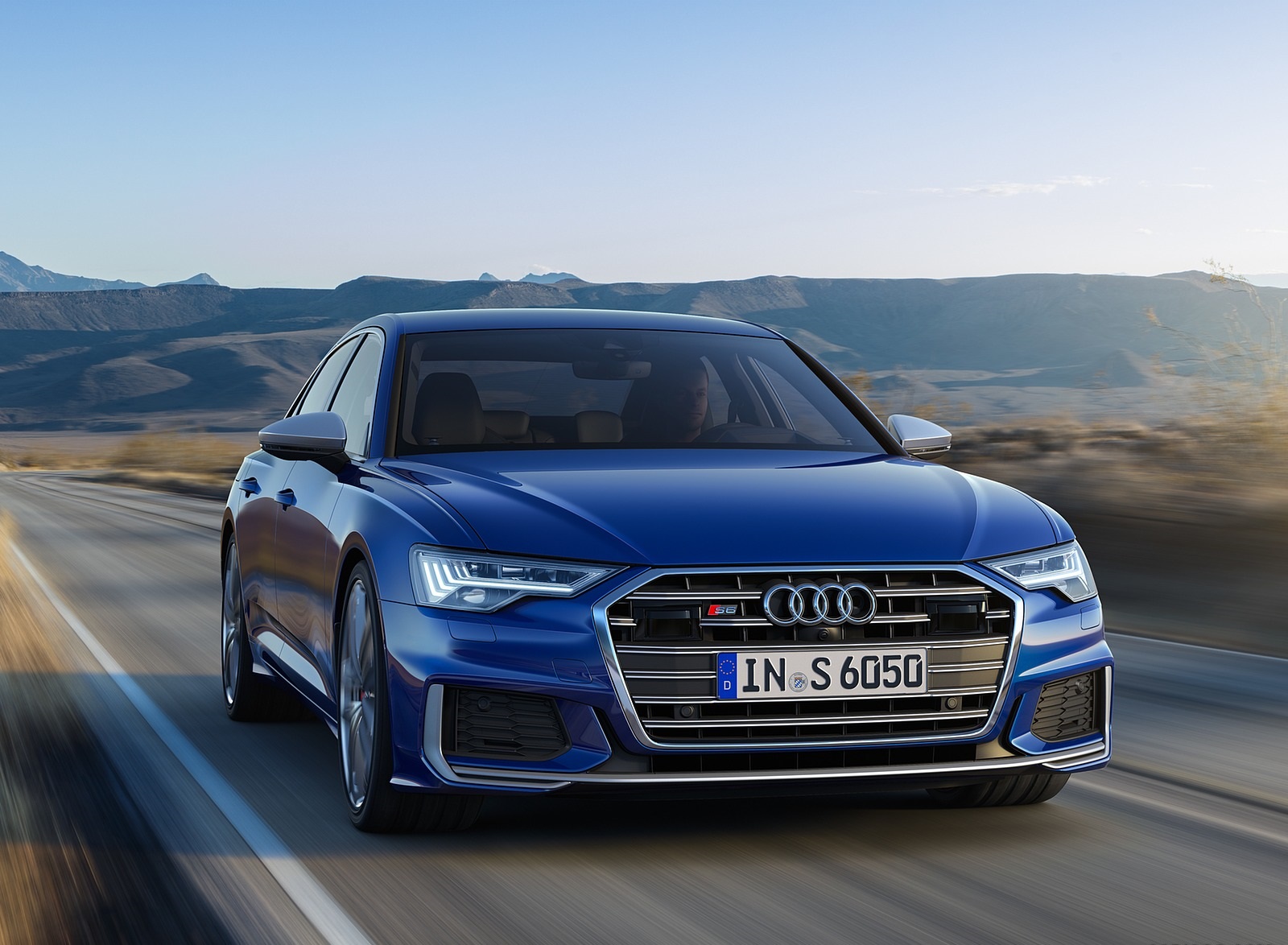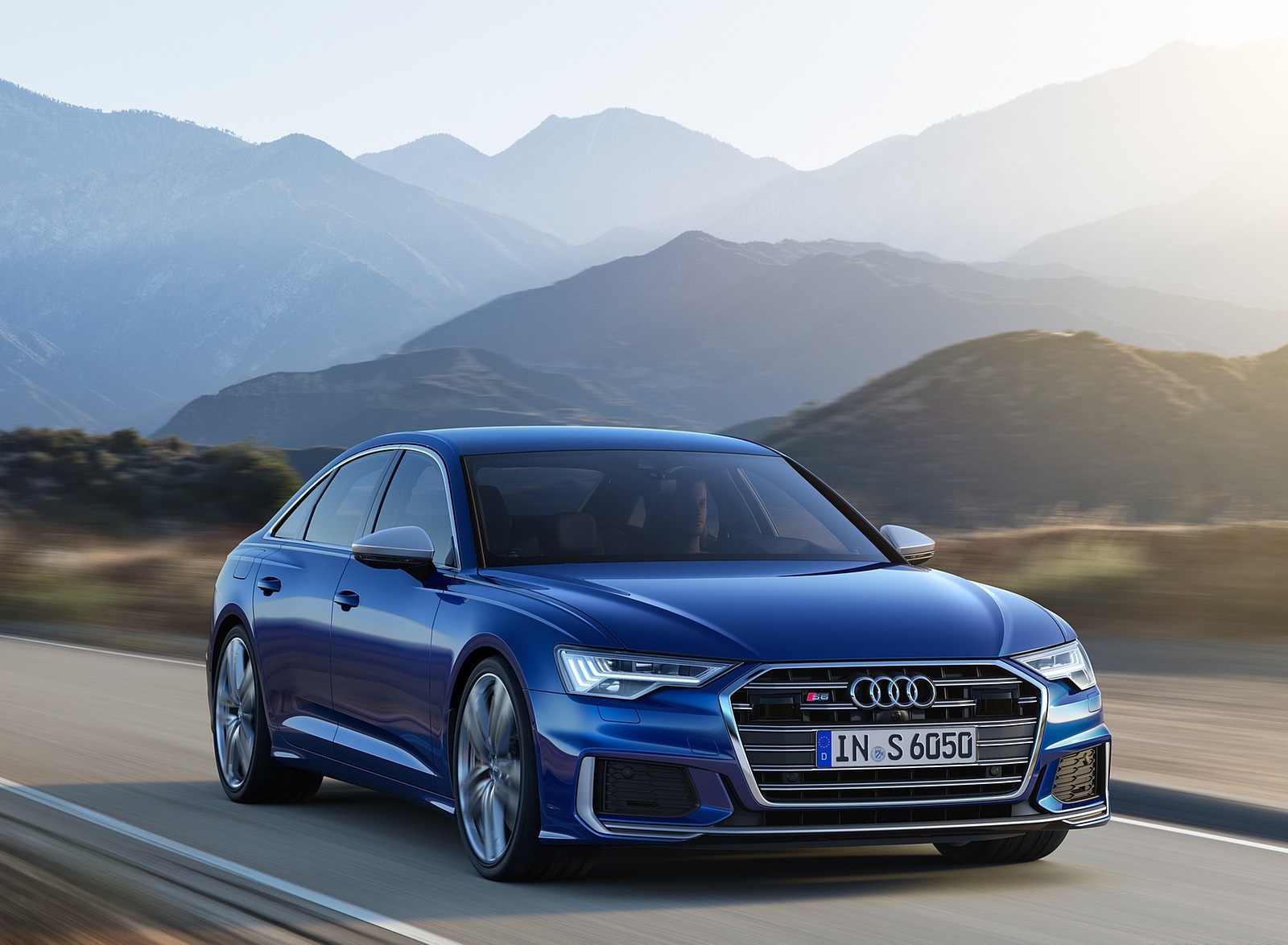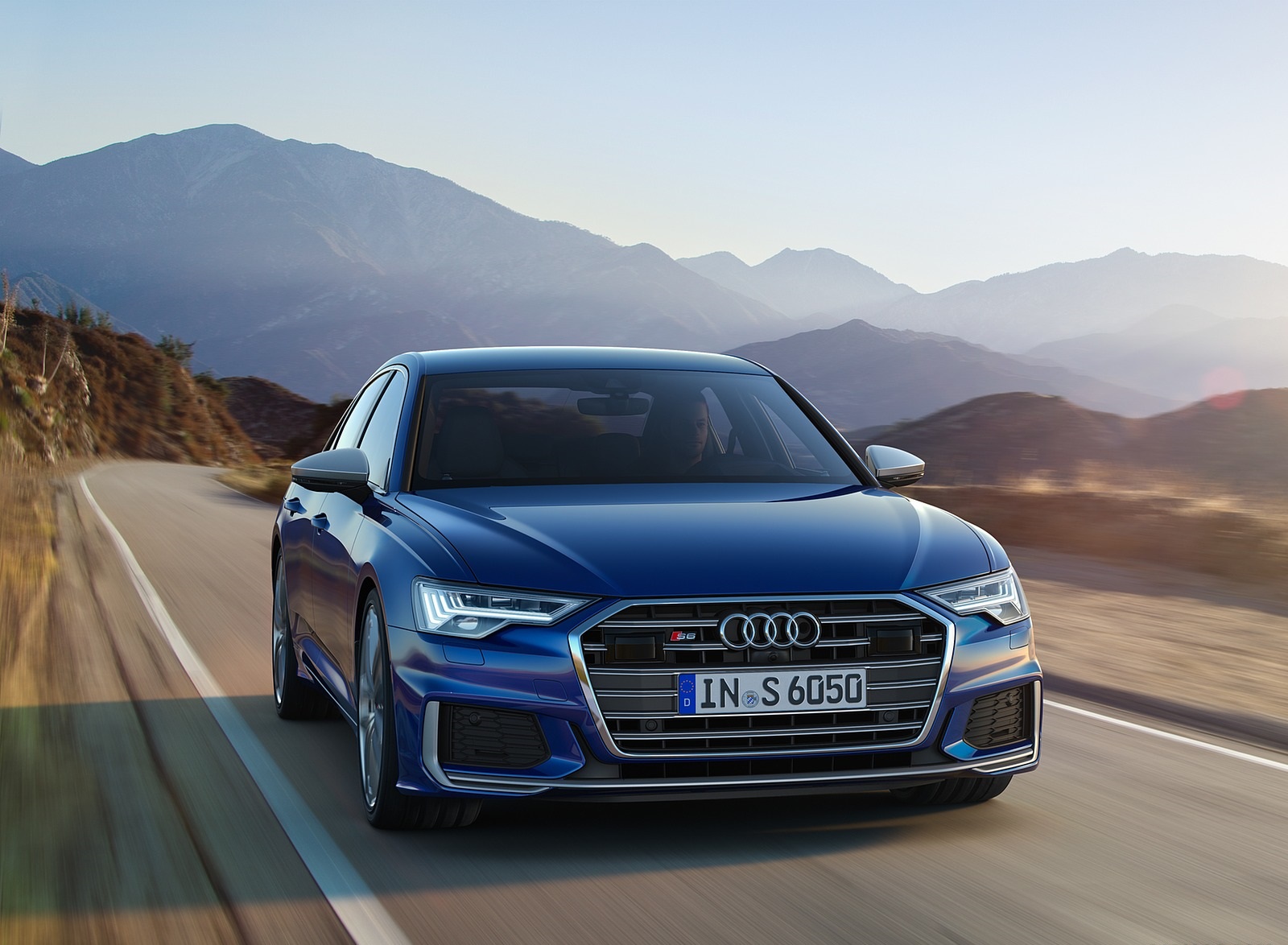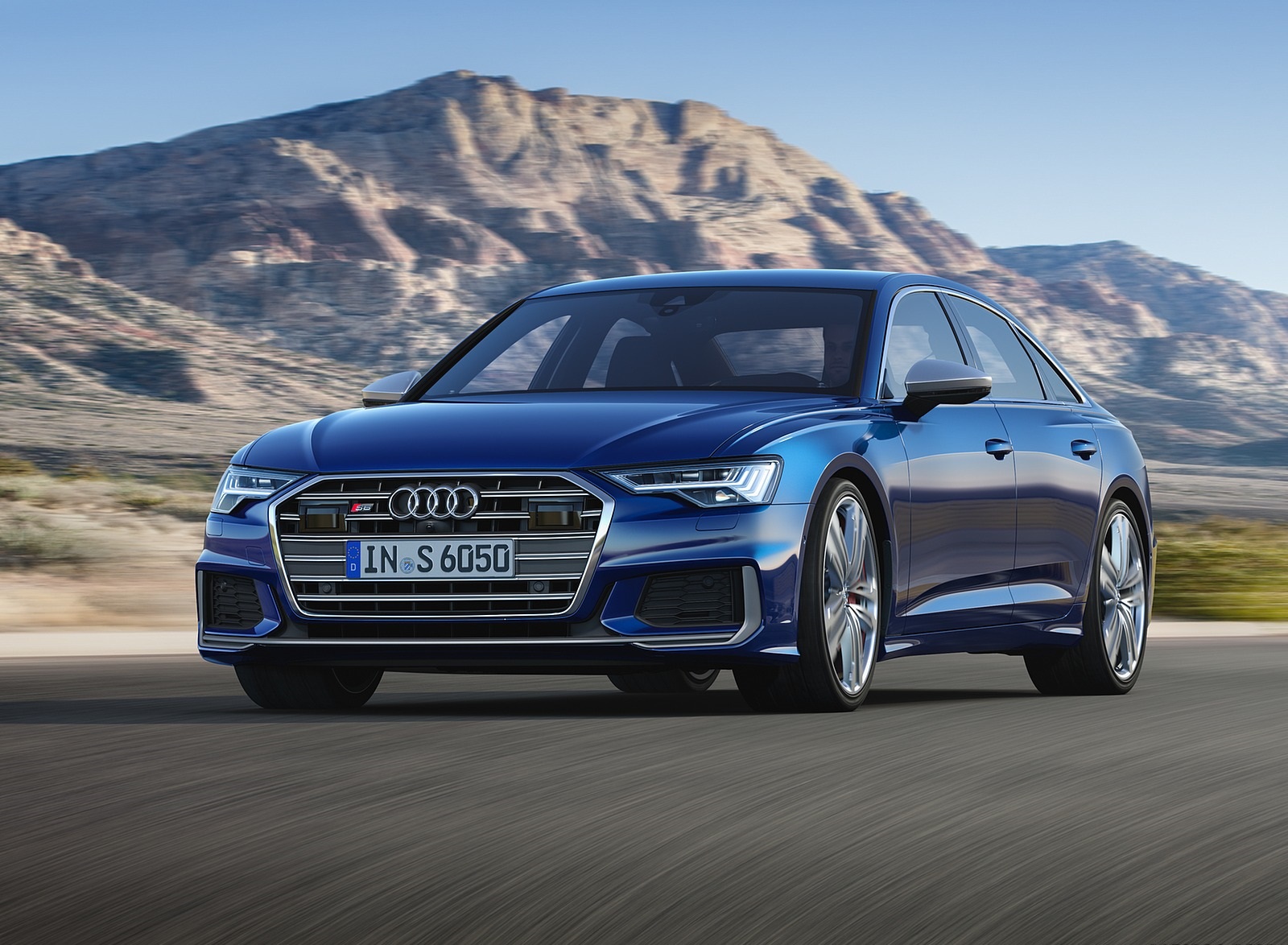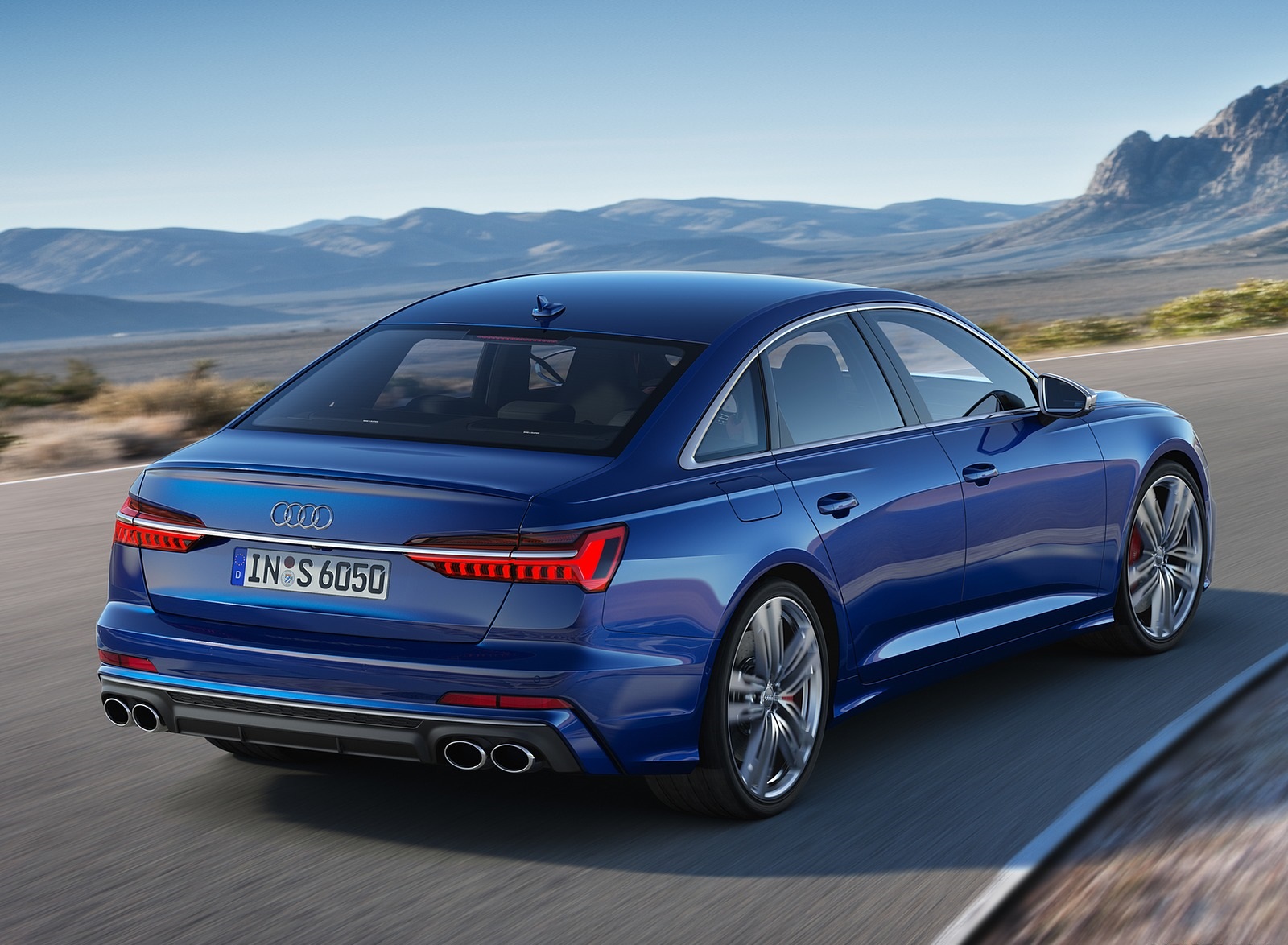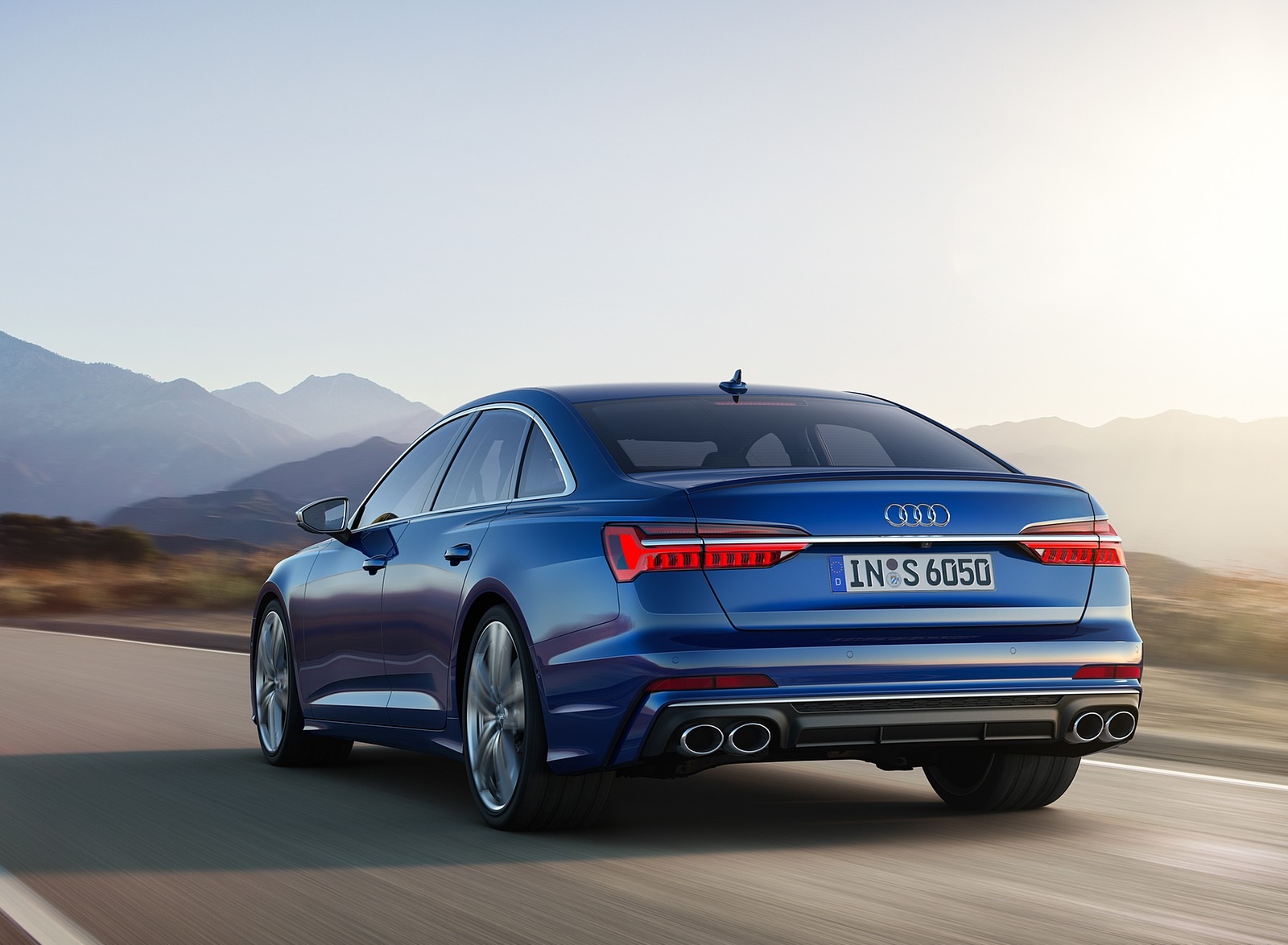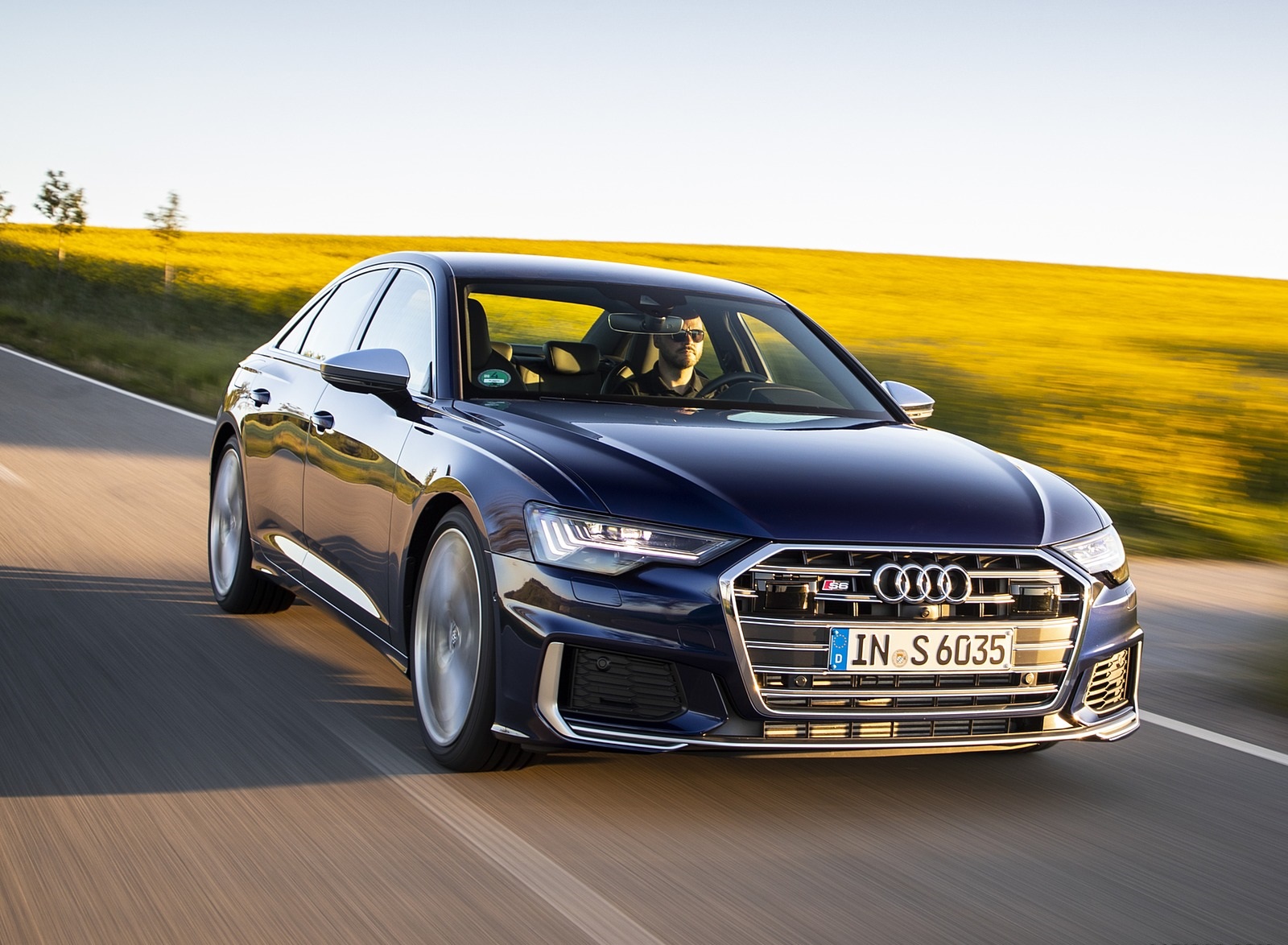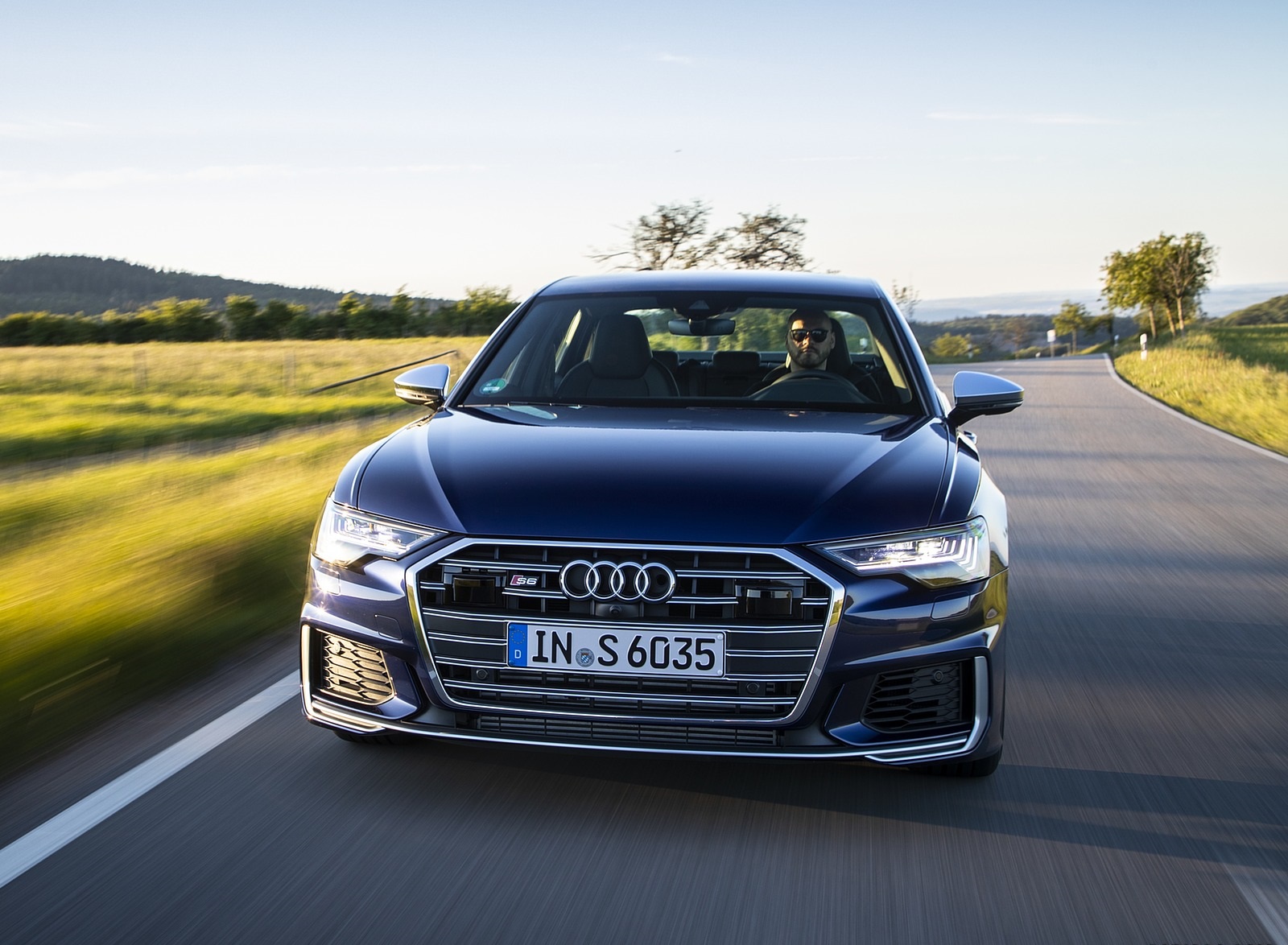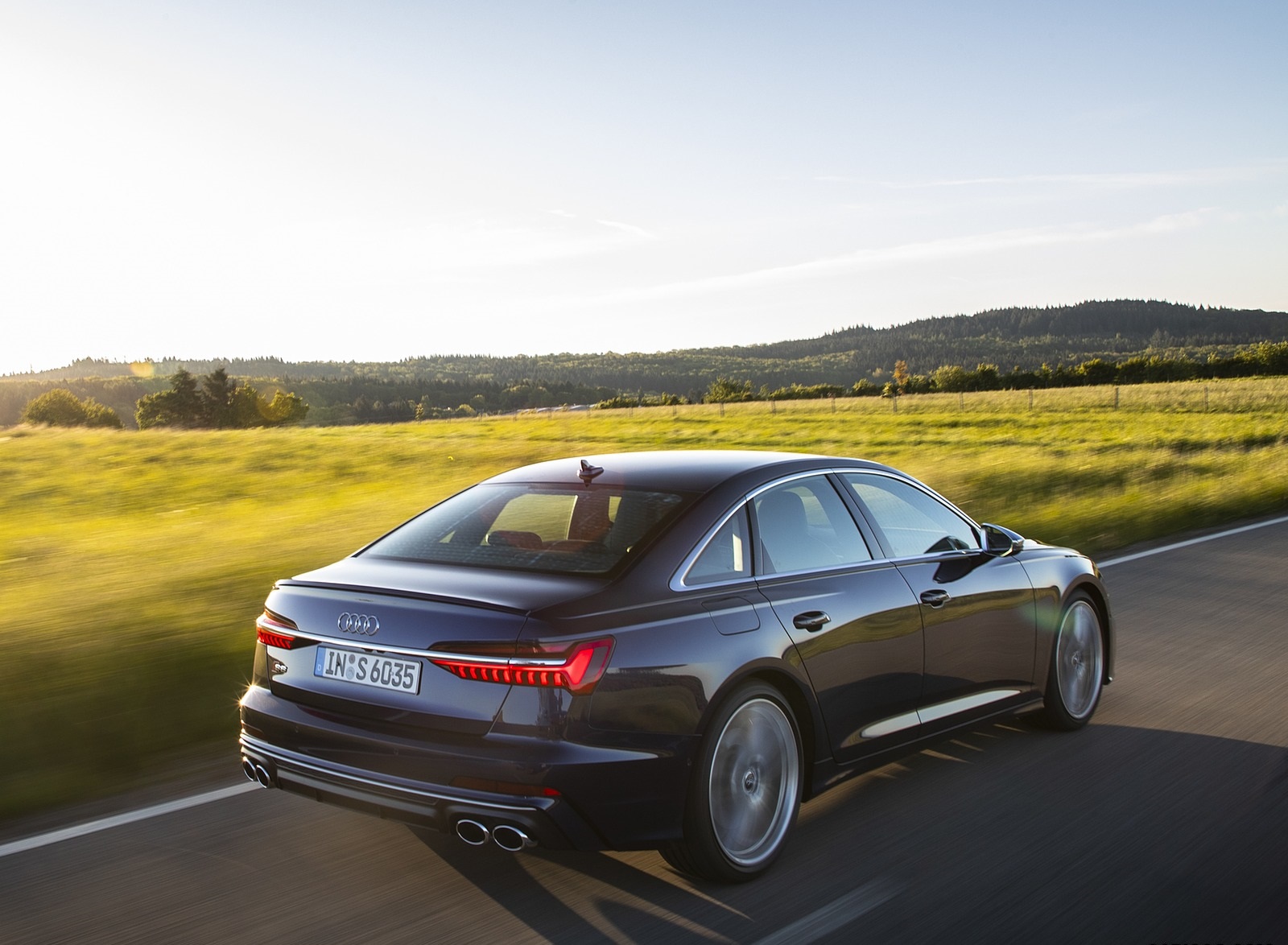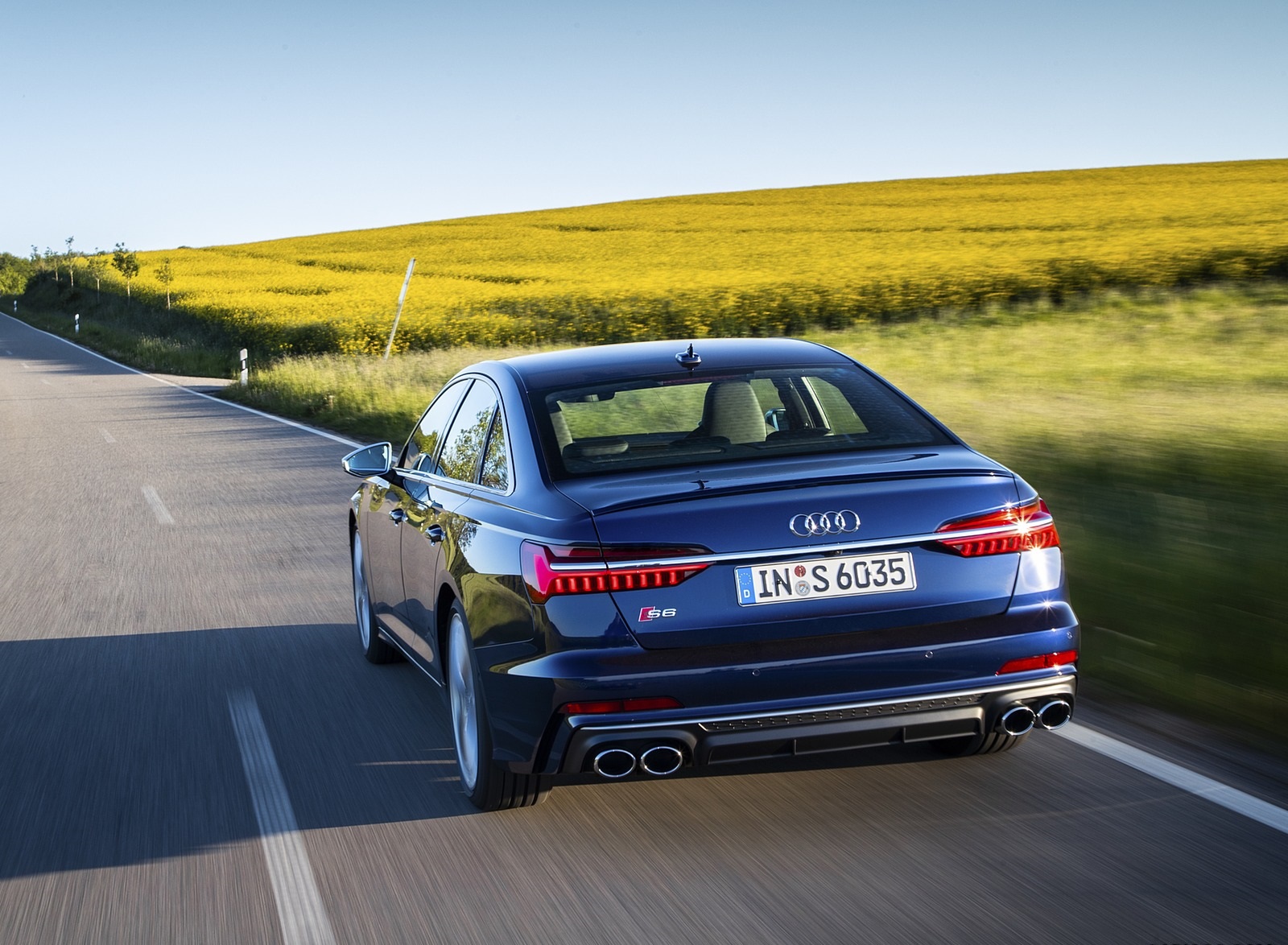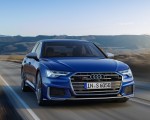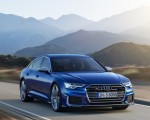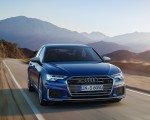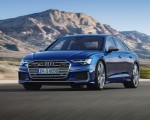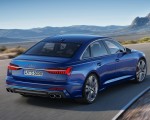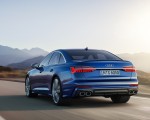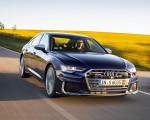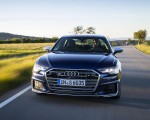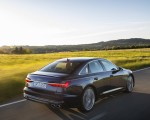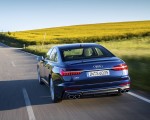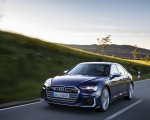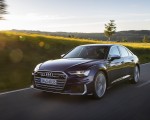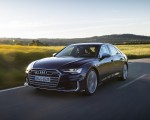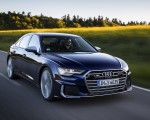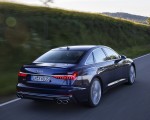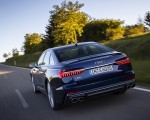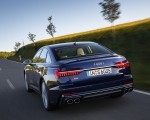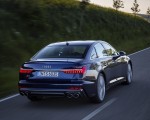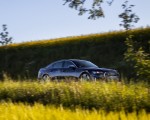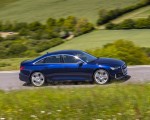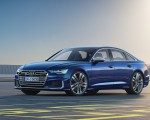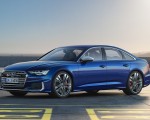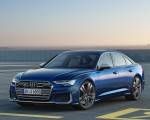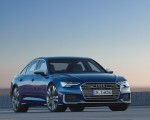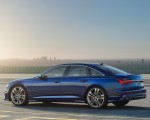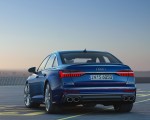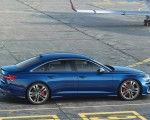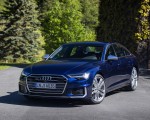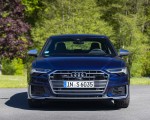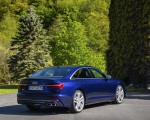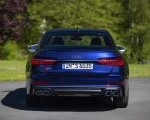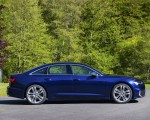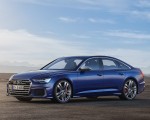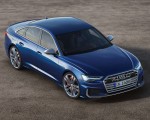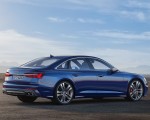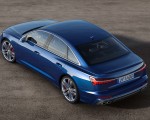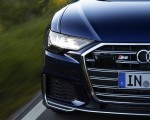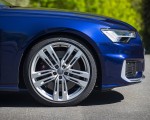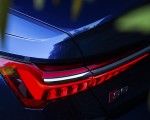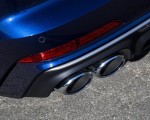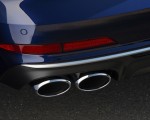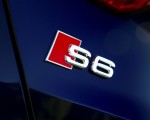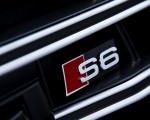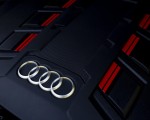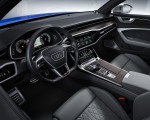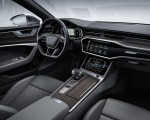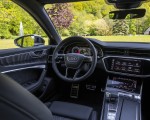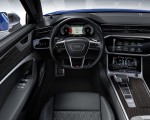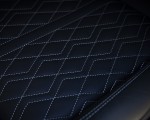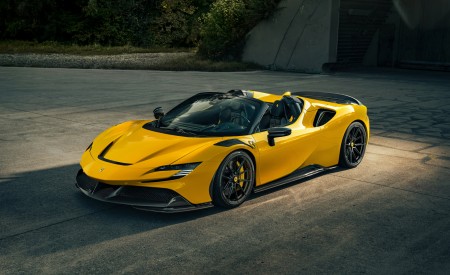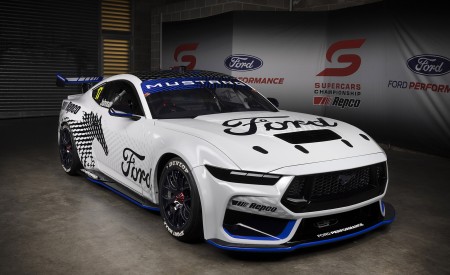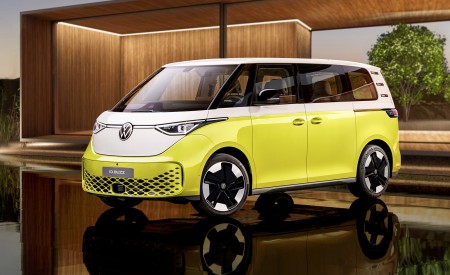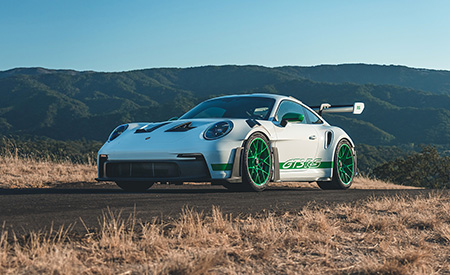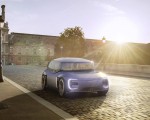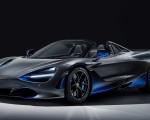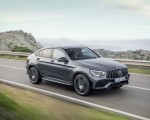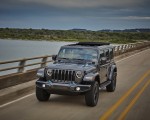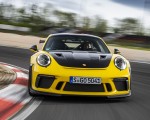2020 Audi S6 Sedan TDI
Performance diesel for the long haul – consistently electric: In its S models, Audi draws on the twin benefits of a TDI drive system and electrification. The Audi S4, S5, S6, S7 and SQ5 models are launching with a three-liter V6 TDI engine, a 48-volt mild hybrid system and an electric powered compressor. A maximum torque of 700 Nm (516.3 lb-ft) and a power output of up to 257 kW (349 metric horsepower) gives the S models ample power on long journeys with low fuel consumption and substantial range. Its outstanding agility makes it the first choice for performance-oriented customers. New suspension modules such as dynamic all-wheel steering and a striking design give the Audi S6 and the S7 Sportback a strong and imposing presence on the road.
In all circumstances, from sporty handling on winding mountain passes to long stretches on the freeway or everyday journeys, the Audi S TDI models combine outstanding agility, instant power buildup and beefy pulling power with low fuel consumption and a long range. Interaction of the high-torque 3.0 V6 TDI with an electric powered compressor (EPC) and a 48-volt mild hybrid system provides the ideal basis for this.
Smooth power delivery and a sporty driving sensation
Thanks to the three-liter V6 TDI engine that generates up to 700 Nm (516.3 lb-ft) of torque from as little as 2500 rpm, the highly responsive electric powered compressor (EPC) and the 48-volt main electrical system that supplies it, the high power output of the drive system is available to the driver across a wide engine speed range. The results: instant responsiveness from just over idling speed and hefty power buildup at a consistently high level of up to 3100 rpm. In addition, in conjunction with the 48-volt mild hybrid system, the V6-TDI engine provides an unrivaled range: For instance, with its 73-liter (19.3 US gal) tank, the S6 sedan can travel some 1170 km (727 mi) with fuel consumption of 6.2 l/100 km (37.9 US mpg).
In the medium-size and full-size class, with the S TDI models, Audi has a wide selection of performance models that cover a broad spectrum from emphatic sportiness to comfort in terms of overall concept, drive system and equipment. This makes them ideal as elegant long-haul cars with a sporty edge: The S4 and S5 are the fast-accelerating models in the medium-size class, the S6 Sedan is the powerful business sedan, the S6 Avant is its elegant station-wagon variant, and the S7 Sportback has the charisma of the four-door Gran Turismo. The newly unveiled second-generation SQ5 TDI follows the tradition of the practical power SUV.
Torque kick: 700 Nm (516.3 lb-ft) torque from a V6 TDI engine, turbocharger, EPC and 48-volt electrical system The S TDI models are aligned with the successful drive concept of the SQ7 TDI (Combined fuel consumption in l/100 km: 7.6 – 7.2*; Combined CO2 emissions in g/km: 199 – 189*) and take it one step further in conjunction with the V6 engine. The large Sport SUV was the first Audi model to be based on an electric powered compressor (EPC), which ensures rapid torque buildup when accelerating. The EPC also delivers that essential kick in the new S models. Here, it has been moved right next to the engine for an even faster response time. This ensures more direct gas paths and even greater efficiency. Interaction of the EPC and the turbocharger enables instant responsiveness and powerful acceleration in all driving situations.
The EPC gets its energy from the 48-volt mild hybrid system, meaning that sufficient electrical energy is on hand in almost every situation. Unlike a conventional turbocharger, it starts up solely by means of electric power. It has a rapid response of around 250 milliseconds. In the range of 2500 to 3100 rpm, the combination of the EPC and the turbocharger allows an instant and even increase in torque with a peak of 700 Nm (516.3 lb-ft). The driver experiences smooth power delivery and a sporty driving sensation on everyday journeys, even at low engine speeds.
For the first time, Audi has combined a 48-volt main electrical system with the EPC and a V-TDI engine. Integration of the electric powered compressor and mild hybrid system (MHEV) into this high-performance main electrical system marks a further step in the large-scale electrification of the brand. While the EPC boosts performance, the MHEV system helps to reduce fuel consumption. At a speed between 55 and 160 km/h (34.2 to 99.4 mph), the car can coast for up to 40 seconds with the engine off. With regenerative braking, the maximum power output is 8 kW. As the mild hybrid system is coupled with the vehicle sensor system, fuel consumption in the S models is reduced by up to 0.4 l/100 km (588.04 US mpg) in real driving conditions.
The three-liter V6 TDI was developed for the high level of driving performance of the S models and is adapted to the increased power output in many respects—with more temperature-resistant aluminum pistons, modifications to the crankshaft and connecting rods, cooling-optimized cylinder heads and an enlarged oil and coolant pump. Overall, these technical adaptations also ensure improved efficiency. Through the outstanding concept of a powerful V6 diesel engine and electrified drivetrain, the S TDI models achieve huge ranges.
All S TDI models have homologation to the Euro 6d temp emission standard. The common rail system injects the fuel through eight-hole nozzles at a pressure of up to 2500 bar, resulting in fine atomization and clean, precise combustion. The performance diesel engines benefit from near-engine exhaust gas aftertreatment, with two large modules working in tandem: The NOC (NOx Oxidation Catalyst) stores the nitrogen oxides until it is full. Cleaning is by means of mixture enrichment in the engine. To minimize the related extra fuel consumption, the NOC kicks in especially at low exhaust temperatures. Once the operating temperature is reached, the second module of the system—the SCR-coated diesel particulate filter—takes care of NOx conversion during intercity and highway driving (i.e. in the moderate engine speed range).
For sporty drivers, design fans and lovers of comfort: Suspension, look and equipment
As well as the drive system, the handling of the S TDI models equips them for dynamic cornering on highways and long freeway stretches. Highly developed suspension technologies ensure enhanced traverse dynamics. The S Sport suspension with damper control is standard in the S6 and S7 models, and the more comfortably tuned adaptive air suspension is also available as an option.
Instead of the standard power steering in the S4 and S5 and the progressive steering in the S6 and S7, on request, Audi provides dynamic steering that adapts your transmission ratio to the driving speed. It is standard in the SQ5. Dynamic all-wheel steering is available as an option in the Audi S6 and S7. The models of the full-size class can be ordered with light, abrasion-resistant carbon-fiber ceramic brake disks, which attain maximum deceleration even at extreme load. In all S TDI models, an eight-speed tiptronic and the quattro permanent all-wheel drive handle power transmission. On request, Audi adds the quattro sport differential, which actively shifts the power between the rear wheels as required and ensures even more agility in dynamic cornering.
The design of the S models emphasizes their sporty and elegant character. With the striking exterior and the distinctly sporty interior, they are instantly eye-catching on the road.
The wide range of standard equipment rounds off the attractive overall concept: In the S6 sedan, S6 Avant and S7 Sportback, the Audi virtual cockpit and the top infotainment system MMI Navigation plus come as standard. The S6 and S7 TDI models go on sale in Europe in May 2019, and the S4 and S5 TDI can also be ordered from May onwards. Customers have been able to order the Audi SQ5 TDI in Germany from EUR 67,750 since March.
Facts and Figures
The Audi S models have a TDI engineS TDI concept
- Electric performance diesel for long trips: the ideal choice for dynamic efficiency
- S TDI combines dynamism with comfort, long-distance capability and a high level of efficiency
- Principle: 3.0-liter V6 TDI, turbocharger, EPC electric powered compressor and 48-volt mild hybrid system (MHEV)
- Advantages of the combination of an S TDI engine, EPC and MHEV: high agility, instant power buildup, beefy pulling power, a long range and low fuel consumption
- Instant responsiveness from just over idling speed and powerful pulling power with up to 700 Nm of torque (516.3 lb-ft)
- Vast ranges: an ample 1,170 km (727 mi) for the S6 sedan with an optional 73-liter (193 US gal) tank and average fuel consumption of 6.2 l/100 km (37.9 US mpg)
- S models cover a broad span from sportiness to comfort in terms of drive system, suspension, equipment and overall concept
Drive system
- 3.0 TDI with 257 kW (349 metric horsepower) in S6 and S7, 255 kW (347 metric horsepower) in S4, S5 and SQ5, 700 Nm (516.3 lb-ft) maximum torque from 2500 to 3100 rpm
- 48-volt main electrical system with electric powered compressor (EPC)
- EPC as an electric compressor for fast torque buildup when accelerating from low engine speeds, up to 7 kW power output, response time approx. 250 milliseconds
- 48-volt main electrical system as a mild hybrid system with a belt alternator starter and 10 Ah lithium-ion battery.
- Coasting and recuperation with power output of up to 8 kW
- Extended start-stop mode up to 22 km/h (13.7 mph)
- Fuel consumption in everyday conditions reduced by up to 0.4 liters of fuel per 100 kilometers (588.04 US mpg)
- Efficient power transmission via eight-speed tiptronic and quattro permanent all-wheel-drive with wheel-selective torque control, quattro sport differential on request
Suspension
- S sport suspension with variable damper control (optional in the S4 and S5), comfort-enhanced adaptive air suspension (S6/S7) on request, adaptive air suspension sport with specific S tuning with variable height adjustment as standard (SQ5 TDI)
- S4, S5 and SQ5 TDI with dynamic steering on request; progressive steering as standard in S6 and S7, dynamic all-wheel steering on request
- Ceramic brake system and large wheels up to 21 inches for S6 and S7 on request
Equipment
- S-specific design features with striking aesthetics and appearance: model-specific front apron with wide air inlets, aluminum louvers with double clasp, aluminum-look front blade and mirror housing, S-specific rear diffuser, S-specific rims
- Look & feel of the interior underscores the sporty overall impression: Interior in dark shades (magma red optional) with colored contrast stitching, aluminum decorative inlays, sports seats/S sports seats with leather/Alcantara covers and S embossing, Audi virtual cockpit with S screen
- Extended equipment: Audi virtual cockpit, MMI navigation plus, Audi connect services, four-zone automatic air conditioning standard in S6 and S7
- SQ5 TDI: market introduction in Europe in summer 2019, base price EUR 67,750
- S4/S5 TDI: market introduction in Europe in May 2019, base prices in Germany EUR 62,600 for S4 sedan, 64,200 for S4 Avant, EUR 65,300 for S5 Coupé and Sportback
- S6/S7 TDI: market introduction in Europe in May 2019, base prices in Germany EUR 76,500 for S6 Sedan, EUR 79,000 for S6 Avant, EUR 82,750 for S7 Sportback
The Technology
TDI + EPC + MHEV = agility, efficiency and range
High level of agility and pulling power, coupled with low fuel consumption, wide range and low emissions: The overall concept of the drivetrain draws heavily on the interaction of a strong and efficient TDI diesel engine, fast torque buildup courtesy of the electric powered compressor (EPC) and the fuel saving ensured by the mild hybrid system (MHEV). With its 700 Nm torque, the turbocharged 3.0 TDI is a smooth power source for the Audi S models. The EPC delivers up to 7 kW and helps the turbocharger when setting off, when accelerating from low engine speeds and in the event of load changes. The V6 diesel and the EPC work in tandem with a 48-volt main electrical system, with which Audi is rigorously bringing the benefits of basic electrification to the series.
The 48-volt system made its debut as an electrical subsystem in the SQ7 TDI, where it also supplies an electric powered compressor. In the new S models, for the first time, Audi has now combined the EPC with a 48-volt main electrical system. A DC converter links up the 12-volt electrical system. The key elements of the 48-volt electrical system—the BAS and the lithium-ion storage battery—make up the mild hybrid system (MHEV). In real driving conditions, it can save up to 0.4 liters of fuel per 100 km (588.04 US mpg).
When the driver takes their foot off the accelerator, depending on the situation, the new S models can run idle with the engine off, coast for up to 40 seconds, or recuperate—in this case, the BAS converts the kinetic energy into electricity and guides it to the 48-volt battery. The operating range of the start-stop system begins at speeds below 22 km/h (13.7 mph).
However, as well as being a vital efficiency mechanism, the 48-volt electrical system also helps to enhance performance in the new S models. The EPC is integrated in the drive management of the MHEV system and uses the recuperated energy stored in the lithium-ion battery to accelerate its compressor wheel rapidly via its electric motor. The high recuperation capacity of the MHEV system means that the EPC is constantly available.
Furthermore, the engine itself, the 3.0 TDI, has also been comprehensively enhanced. The pistons, crankshaft, connecting rods and oil pump were specifically designed to meet the requirements of improved performance while delivering the outstanding fuel efficiency that typifies the TDI. The cooling system also covers the EPC, the BAS and the compressor housing of the turbocharger.
The high level of sophistication allows sporty driving performance and provides an outstanding balance with low fuel consumption. That’s how the S4 and S5 models are able to sprint from 0 to 100 km/h (62.1 mph) in 4.8 seconds. The Audi S6 sedan covers this distance in 5.0 seconds. It takes the S7 Sportback and the SQ5 TDI a tenth of a second longer to do this standard sprint. The electronically limited top speed for all models is 250 km/h (155.3 mph). All S TDI models have homologation to the Euro 6d temp emission standard.
Overview of the System Structure
Engine: Three-liter V6 TDI
The 3.0 TDI that powers the new S models is the latest, extensively enhanced development stage of the V6 diesel engine. In the S6 Sedan, S6 Avant and S7 Sportback, its 2,967 cm3 cubic capacity produces 257 kW (349 metric horsepower) power output and 700 Nm (516.3 lb-ft) torque (Combined fuel consumption in l/100 km: 6.5 – 6.2*; Combined CO2 emissions in g/km: 171 – 164*). This torque is available from 2500 to 3100 rpm. The specific output is 117.9 metric horsepower per liter of engine capacity, and the specific torque is 235.9 Nm (174.0 lb-ft) per liter. In the Audi S4, S5 and SQ5, the key figures are 255 kW (347 metric horsepower) and 700 Nm (Combined fuel consumption in l/100 km: 6.8 – 6.2*; Combined CO2 emissions in g/km: 177 – 161*).
The V6 diesel engine, which works at high ignition pressures of up to 205 bar, boasts sophisticated high-tech components in all areas. The pistons are made of highly heat-resistant aluminum material and has revised geometry. The connecting rods and crankshaft have been adapted accordingly. An enlarged wheel set boosts the efficiency of the oil pump, while additional cooling plates in the oil cooler ensure improved cooling capacity. The water-cooling circuits of the crankcase and cylinder heads are kept separate so that the engine oil warms up rapidly from a cold start. This substantially reduces friction losses and, therefore, fuel consumption. The heads have dual-section water jackets. In their upper section, the coolant circulates more slowly than in the hard-working lower section. As a result of this solution, flow losses are reduced and the water pump needs less drive energy.
The large turbocharger develops up to 2.4 bar relative boost pressure—it can push through up to 1100 kg (2425.08 lb) of air per hour. Its variable turbine geometry (VTG) is optimized for low-loss flow. The additional low-pressure exhaust-gas recirculation, which is active in most driving situations, extracts the exhaust gas behind the components of the emissions control system and reintroduces it in front of the compressor. Consequently—in contrast with purely high-pressure exhaust-gas recirculation—it allows the turbocharger to be powered with the full mass flow, thus making it much more effective. With the high rates of recirculated exhaust gas, combustion takes place at lower temperatures, resulting in significantly reduced NOx raw emissions.
The common rail system is also a major factor in clean emissions. It injects the fuel through eight-hole nozzles at pressures of up to 2500 bar. In each cycle, it can perform up to seven separate individual injections. This means fine atomization and clean, precise combustion. The new S TDI models* are certified according to the Euro 6d-temp emission standard (68 mg NOx/km).
The performance diesel engines benefit from near-engine exhaust gas aftertreatment, with three modules working in tandem: The NOx oxidation catalyst stores the nitrogen oxides until it is full. Cleaning is by means of mixture enrichment in the engine. To minimize the related extra fuel consumption, the catalyst kicks in especially at low exhaust temperatures.
Once the operating temperature is reached, the second module of the system—the SCR-coated diesel particulate filter—takes care of NOx conversion in most driving conditions. Its enhanced SCR coating also guarantees stable conversion of nitrous oxides to harmless nitrogen at high loads—for instance when pulling a trailer. The AdBlue solution that facilitates the conversion. A downstream SCR catalyst is the last component of the emissions control system.
EPC: Electric powered compressor
The EPC is the ideal partner for the turbocharger. It handles buildup of the boost pressure whenever insufficient exhaust-gas energy is available to power the turbocharger. The EPC eliminates the turbo lag—with its electric drive, it supplies the air that the engine needs for combustion. As a result, the TDI instantly produces more power output and torque and consequently enough exhaust gas to power the conventional turbocharger.
The EPC is positioned in the intake-air path behind the intercooler close to the throttle valve—a layout that guarantees an instant response. In most operating conditions, the intake air flows past the EPC and straight to the engine. However if the load demanded by the accelerator is high and the energy available on the turbine side of the turbocharger is low, the throttle valve closes the direct air path. Now, the intake air reaches the EPC via a bypass and is compressed there at a pressure of up to 2.4 bar. A small electric motor accelerates the compressor wheel with a power output of up to 7 kW. In under 250 milliseconds, it takes the turbine, which is 68 mm (2.7 in) in diameter, to up to 70,000 rpm.
With this extra impetus, the EPC enables a fast response and powerful acceleration in all driving situations, such as overtaking, exiting corners, or sudden short bursts of speed. As it is coupled with the mild hybrid system, the EPC can also apply its full power output several times in quick succession. This results in strong, uniformly increasing torque.
MHEV: Mild hybrid technology and 48-volt main electrical system
The EPC is based on the 48-volt mild hybrid system. Essentially, it consists of two components: a belt alternator starter connected to the crankshaft via a V-ribbed belt and a 10 Ah-capacity lithium-ion battery housed under the loading floor of the luggage compartment. Together, they constitute the mild hybrid system of the new S models. This system can reduce fuel consumption in real driving conditions by up to 0.4 l/100 km (588.04 US mpg) by virtue of its intelligent control via the predictive efficiency assist and its coupling with the vehicle sensor system.
If the driver takes their foot off the accelerator at a speed between 55 and 160 km/h (34.2 to 99.4 mph), the drive management selects one of three solutions depending on the driving situation: The S models can recuperate, run idle, or coast for up to 40 seconds with the engine off. The information provided by the predictive efficiency assist (standard in the S6 Sedan, S6 Avant and S7 Sportback) forms a basis for this. This device accesses the route map of the standard navigation system and the data of the on-board sensors. The setting in the Audi drive select dynamic handling system also plays a major role: Recuperation tends to be higher in the dynamic profile, while efficiency mode paves the way for cruising.
The mild hybrid system is coupled with the vehicle sensor system. Consequently, predictive recuperation is also possible. For example, if a vehicle ahead brakes, the radar sensor of the standard Audi pre sense system detects the situation, and the intelligent drive management independently selects fuel-saving coast or recuperation mode.
In the case of recuperation, the BAS converts the kinetic energy into electricity and then feeds it to the lithium-ion battery. When coasting—i.e. when the foot is taken off the accelerator—it can reduce the power output of the running vehicle by up to 4 kW by acting as a generator. In the case of slight braking, the reduction is as much as 8 kW—deceleration is effected purely electrically in this range. If the pedal is pressed beyond a specific distance, i.e. harder braking is required, the hydraulic wheel brakes account for most of the deceleration. Recuperation only ends when the driver takes their foot off the brake. If the driver accelerates again, the BAS restarts the engine—depending on the situation, faster and more smoothly than a conventional starter. Start-stop operation begins at a residual speed of 22 km/h (13.7 mph). When stopped, the engine starts up while the brake pedal is still depressed as soon as the vehicle in front begins to move.
Overview of the Audi S TDI Models
Performance, presence and comfort—the Audi S4, S5, S6, S7 and SQ5 TDI combine sporty driving performance with highly expressive design and a high level of everyday usability. The overall concept of the S models thus allows a broad span from dynamic driving performance to outstanding comfort. This has always been a defining characteristic of the performance models of the brand with the four rings.
The new drive concept with the TDI engine, EPC and MHEV system underlines this fact. quattro permanent all-wheel drive and the S sport suspension with damper control applies the power smoothly to the road. New suspension components and suspensions with model-specific tuning emphasize both the agility and the long-distance capability of the S models. The extended range of standard equipment in terms of infotainment, connectivity and comfort features helps to make the S models true long-distance winners.
Performance: Power transmission and suspension
In the new S models, a fast and smoothly shifting eight-speed tiptronic handles power transfer. It contains a rotational speed-adaptive absorber that largely compensates for the vibrations of the 3.0 TDI at very low engine speeds.
New detailed solutions make the automatic transmission fit for interaction with the MHEV technology. An additional electric oil pump ensures lubrication of the gearbox if the combustion engine is deactivated while driving. In this situation, known as “coasting”, it makes it possible to engage the gear required on restart. During “coasting” and when “freewheeling”, when the vehicle moves with the engine idle, a clutch in the central transmission is opened. In both situations, this reduces the friction losses that occur in the drivetrain.
As in all S models from Audi, quattro permanent all-wheel drive comes as standard. In normal driving conditions, its self-locking center differential distributes torque between the front and rear axle in a 40:60 ratio. When slip is detected, the majority of the power is directed to the axle with the better traction. In extreme cases, a maximum of 70 percent can flow to the front or 85 percent to the rear. Wheel-selective torque control, an intelligent software function, perfectly complements the quattro drive. During dynamic cornering, it brakes the wheels with reduced load on the inside of the curve minimally before they can begin to spin. As a result, the car turn into the curve ever so slightly—making handling even more sporty, agile and stable.
Audi installs the sport differential in all new S models on request. During fast cornering, it actively transfers most of the drive torque to the outside wheel, which has more traction. This effect literally pushes the car into the curve, nipping understeer in the bud.
Compared with its predecessors, the S models are also much improved in terms of traverse dynamics. Progressive steering, which operates more and more directly as the turning angle increases, is fitted in the S6 and S7 series. On request, Audi installs dynamic steering in the S4, S5 and SQ5 TDI. This system improves the transmission ratio of the vehicles by nearly 100 percent, depending on the speed. An even more sophisticated solution is available, dynamic all-wheel drive, is available in the S6 Limousine, S6 Avant and S7 Sportback. Here, the rear wheels are also steered via a spindle drive and track rods, depending on the situation. Up to 60 km/h (37.3 mph), they turn up to five degrees in the opposite direction to the front wheels, thus reducing the turning circle by up to 1.1 m (3.6 ft). At higher speeds, they steer up to two degrees in the same direction as the front wheels, which improves stability.
Audi equips the S6 and S7 with an S sport suspension with damper control as standard. It lowers the body by 10 mm (0.4 in) in the S7 Sportback, by 20 mm (0.8 in) in the S6 Sedan and S6 Avant and by 30 mm (1.2 in) in the SQ5 TDI. In the S4 and S5, the S sport suspension lowers the center of gravity by 23 mm (0.9 in). For the first time, the adaptive air suspension with variable damping is available for the S6 and S7. It can be set to three modes and includes a “lift” position for poor roads and automatic leveling. In “auto” mode, the body is lowered by a further 10 millimeters (0.4 in) at 120 km/h (74.6 mph), and in “dynamic” mode, the body remains always at this low ride height.
With the variable suspension and the air suspension, the electronic chassis platform (ECP) acts as the central control mechanism in the parent-class models. It also manages the optional dynamic all-wheel steering and sport differential systems and coordinates their functioning quickly and precisely. The driver can adjust the operation of these and other technical components in the Audi drive select system individually in line with their own preferences. The system comes with an S-specific setup and offers the diverse modes comfort, auto, dynamic, efficiency and individual. In SQ5 TDI, the offroad and allroad profiles are also available.
The brake disks of the new S models have a diameter of up to 400 mm (15.7 in) on the front axle and 350 mm (13.8 in) on the rear axle. Their six-piston calipers—optionally painted in red—are made of aluminum and bear S logos. On request, Audi installs carbon-fiber ceramic disks in the S6 and S7. They also have a diameter of 400 mm (15.7 in) on the front axle. The ceramic brake system is 9.0 kg (19.8 lb) lighter than the steel brakes.
The Audi S6 Sedan, S6 Avant and S7 Sportback are fitted with 20-inch wheels with 255/40 tires as standard; the SQ5 TDI has the 255/45 format. 21-inch wheels are available as an option. 255/35 tires are fitted here, while the SQ5 TDI has 255/40 tires. From the Audi Sport GmbH wheel range, there are 20-inch performance tires that provide even more adhesion and dynamic handling.
Presence: Striking design, sporty and sophisticated look and feel
The new S models are characterized by their individual design—outside and inside alike. They radiate their entirely distinctive, sporty yet understated character. An emphatic bumper with large air intakes, S trim elements in dark chrome and with an aluminum look, for instance on the radiator grille and front spoiler, striking side sills, exterior mirror housings in aluminum look, a wide rear diffuser, and four tailpipe trims give them a strong presence on the road.
The interior boasts the typical S model look—with color schemes characterized by cool, dark tones, with aluminum decorative inlays, contrast stitching and model-specific equipment details. Sports seats with leather/Alcantara covers and S embossing come as standard. Alternatively, in the S6 Sedan, S6 Avant and S7 Sportback, there are the heavily contoured S sports seats with integrated head restraints and a diamond pattern, which are standard in the S7 Sportback, as well as the highly adjustable customized contour seats, optionally with ventilation and a massage function. Here too, the covers are available in top-quality Valcona leather. Several leather packages and decorative inlays are available to customize the interior further.
In all S models, the footrests and pedal caps are made of stainless steel, and illuminated aluminum strips greet the driver on entering the car. In the full-size class, the S-specific features also include the graphic layout of the standard Audi virtual cockpit with a 12.3-inch display. Its focal point is a central rev counter and the figures are shown in red on a black background. In the Audi S4, S5 and SQ5, the standard equipment includes the driver information system with 7-inch color display.
Comfort: Equipment for the long haul
The six new S models are extensively equipped. Along with the features already mentioned, LED headlights are standard across the range, while the Audi virtual cockpit and four-zone automatic air conditioning are also included in the S6 Sedan, S6 Avant and S7 Sportback. There are a wide range of infotainment and Audi connect services.
And the driver assistant systems in the new S models also provide a host of convenient features. In the S6 Sedan, S6 Avant and S7 Sportback, adaptive cruise assist (ACA) stands out from the extensive range—with its subfunctions, it helps with longitudinal and lateral control from standstill to top speed. In conjunction with the standard efficiency assistant, the ACA can accelerate and decelerate the large Avant independently. In the SQ5 TDI, longitudinal and lateral control are allocated to the adaptive cruise control and Audi active lane assist.
What makes the Audi S models such excellent long-haul cars is not just their high range, but also their rigid body structure, which forms the basis for their precise handling, low level of interior noise and outstanding crash safety. Further strengths are the sophisticated aerodynamics and aeroacoustics and the spacious interior and luggage compartment.
The S models will be launched on the European markets in spring and summer 2019. Base prices in Germany are EUR 62,600 for the S4 sedan, EUR 64,200 for the S4 Avant, EUR 65,300 for the S5 Coupé and Sportback, EUR 76,500 for the S6 sedan, EUR 79,000 for the S6 Avant, EUR 82,750 for the S7 Sportback and EUR 67,750 for the SQ5 TDI.
